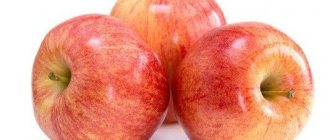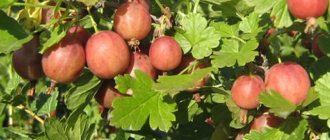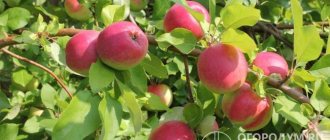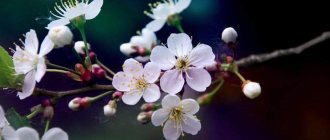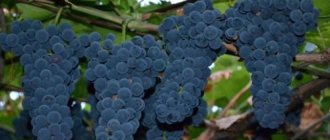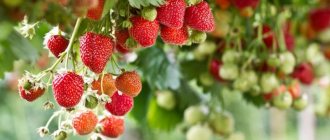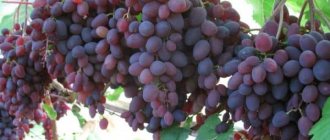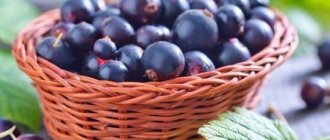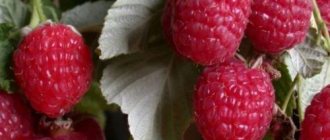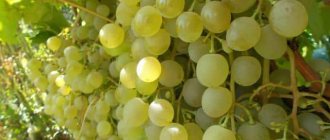Description of the apple tree Elena
Elena is one of the popular apple varieties. Hybrid variety of Belarusian selection. Bred by crossing the Discovery apple tree and the Early Sweet variety in 2000. The trees are low-growing, compact in shape, and have medium growth vigor. The height of the trees is up to 3 m. Elena’s apples look beautiful not only in the photo, but also in their natural form.
The crown of the tree is pyramidal-oval in shape and has medium density. The shoots of the apple tree are thick, rounded and have dark red bark.
The leaves are also medium in size, elliptical in shape, dark green in color with a gray coating on the inside.
The branches are abundantly strewn with foliage, especially at the edges. Flowering period - late April or early May. The flowers are white, fragrant, and the apple tree is densely strewn with them.
In terms of fruiting and ripening time, this is the earliest apple variety. The first fruits appear in the second year after planting.
The Elena variety is a frost-resistant variety. It tolerates very severe cold winters with severe frosts well. It is enough to cover the roots of the tree with snow or spruce branches in the fall.
The fruits have a beautiful round shape. The main color of apples is green, but a bright pink blush forms over a larger area. White dots are noticeable. The skin is smooth and dense, but does not affect the taste of the fruit.
History of selection
The fruit was obtained by Belarusian scientists in the 21st century. Z. A. Kozlovskaya, E. V. Semashko, and also G. M. Marudo took part in the creation of a variety of apples. The apple tree was obtained by crossing apples of the Early Sweet variety and the Discovery variety.
The method practiced by Russian breeders was taken as an example. Since both varieties have decent characteristics, the hybrid inherited taste and aroma, juiciness and early ripening from them.
In 2001, the Elena variety apple tree was approved for cultivation in the Mogilev region (in eastern Belarus), and was later distributed throughout Europe. The hybrid was grown using the mentor method in harsh conditions.
Pros and cons of the Elena apple tree variety
The advantages of the Elena apple tree variety in the photo and the description of the variety give no reason to doubt the uniqueness of this hybrid. This is a beautiful tree that has a huge number of advantages compared to other apple trees. Among the main advantages:
- small trees are easy to care for and harvest;
- precocity and precociousness;
- high resistance to frost;
- bears fruit annually;
- no additional pollinator is needed, so it is suitable for small areas where only one tree can be planted;
- The fruits are beautiful, even in size and have high taste.
But the Elena apple tree variety also has its drawbacks. First of all, this is low safety. These apples should not be stored for longer than 2-3 weeks. It is better to use for processing into jam, juices and compotes. During processing, you will need a minimal amount of sugar, since Elena apples contain more than 10% sugar. This significantly saves resources during procurement.
The variety is also poorly preserved if it is not removed from the trees in time. In this case, the apples lose their taste, become overripe, and crumble.
Therefore, it is important to remove all the fruits before they begin to fall off.
Characteristics of the variety
Apples of the Elena variety look beautiful not only in the photo, but also on the branches in the garden. This hybrid surpassed its parents in quality and other indicators.
The fruits are round in shape and green; when harvested, they are pink-red with subcutaneous white dots, which gives them an unusual appearance. The taste is sweet, practically no sourness, weight 120-150 grams. The pulp is fine-grained, juicy, white-pink in color. When ripe it has pink inclusions.
Ripe apple fruits.
Advantages and disadvantages
Gardeners say that any variety has its pros and cons, but this variety has almost no disadvantages.
Main advantages:
- low tree growth;
- precocity and precociousness;
- annual fruiting;
- frost resistance;
- does not require pollinators;
- smooth, beautiful fruits of high quality.
The disadvantage is the low preservation of fruits: up to 3 weeks. After this, the fruits lose their juiciness. Therefore, it is important to remove them and recycle them in a timely manner.
Tasting assessment
When the fruits are fully ripe, a pleasant sweet taste and characteristic apple aroma appear on the tree. Experts rate the high taste qualities of apples at 4.8 out of 5.
Tree height and crown features
The apple tree usually grows in height up to three meters, and is considered medium-sized or even low. The crown of the apple tree has the shape of a pyramid or oval, with dense branches completely covered with leaves.
Mature apple tree.
Self-fertility and productivity
The Elena variety apple tree is self-fertile and does not need pollinating neighbors. The flowering is fragrant, which attracts insects; pollination occurs in large quantities. The branches will need to be supported by supports, because they can break off under the weight of the fruit.
Winter hardiness
Apple trees were originally zoned for temperate climates. But they survive the winter, because their frost resistance is quite high. When planted in a more severe climate, they need additional fertilizing of the soil and plant.
Disease resistance
The Elena apple tree is characterized by increased resistance to most diseases, but can be affected by scab, powdery mildew, and milky sheen, especially in conditions of high humidity. Spring preventive spraying is an important part of care.
Optimal growing conditions
The Elena variety is intended for cultivation in the temperate climate of the middle zone. This means that in colder regions additional feeding will be needed, and in hotter and drier climates additional watering will be needed.
It is important to understand that in constantly hot and dry weather the tree will not receive enough nutrients, and therefore ovaries will not form after flowering. The flowers will simply fall off, but there will be no fruiting. So all the flowers may fall off without producing fruit.
But it is possible to be left without a harvest only in dry and arid regions, and in other climatic zones the Elena apple tree can do without watering, and the harvest will not decrease as a result.
Growing in regions
Basically, this hybrid is adapted to the temperate climate that exists in central Russia and Belarus.
Since it was bred in Belarus, it is winter-hardy for these latitudes, ripening at the end of July.
But this in no way prohibits the cultivation of this crop in other latitudes. In a different climate, additional conditions will be required and the yield may decrease.
If this applies to the Siberian regions, then when the soil freezes, it loses many nutrients and microelements.
Therefore, when grown in such harsh conditions, it is necessary to feed the plant in a timely manner , creating less harsh conditions for it in the winter season.
This is done by abundant mulching for the winter or increasing the snow cover around the trunk, which does not allow the roots to completely freeze out.
In the southern regions there are no problems with winter hardiness, but periodic, abundant watering and preservation of the ovaries is required if they are exposed to extreme heat.
If timely watering is not observed in hot climates, the soil quickly dries out, which creates difficulty in absorbing nutrition. Due to lack of nutrition, the color disappears, and the ovary does not form.
Important! Problems with watering exist only in the southern regions. In temperate latitudes, natural irrigation in the form of rain is sufficient.
Timely measures will give good yield.
Planting and caring for a summer apple tree Elena
For a good harvest, it is important to properly care for the tree. Competent agricultural technology begins with planting. With proper and abundant flowering, the harvest is stable. There are some nuances in caring for this tree that the gardener must take into account.
Selection and preparation of a landing site
The optimal soil for planting is considered to be slightly acidic loamy chernozem. If the soil is heavier, you will need to add peat, rotted manure or coarse sand. The place should be sunny if possible. Then the yield will be as high as possible. Groundwater should not pass closer than 2.5 m from the surface. Otherwise, the roots will not be able to develop fully.
The Elena apple tree variety tolerates being in close proximity to other apple trees, helping them as a pollinator. But it is advisable that the shadow does not fall too much on the seedling.
To prepare for planting, you need to dig a hole measuring 80x90 cm. This hole should be prepared a week before planting. A layer of humus or compost must be placed at the bottom. After 7 days you can start planting.
Seedling preparation
In order for the apple tree to take root, it is necessary to carefully select seedlings. Properly selected planting material will help to obtain maximum yield in the second year.
First of all, you should pay attention to the condition of the roots. It is the root system that is the basis of a future healthy tree. If stored poorly, the roots will look limp and shriveled.
The roots should be in a nutritious and cool environment, so they are better preserved. Therefore, when purchasing, you should make sure that the roots are not bare, but are located in a clod of earth or nutrient soil.
A healthy seedling is smooth, straight, without wounds or damage. The optimal age of a good seedling is two years.
Landing rules
Apple trees can be planted 2 times a year: in the spring until the end of April and in the fall after the leaves fall.
A stake 120 cm long should be driven into the pre-prepared nutrient mixture in the pit.
Loosen the soil around the stake and make a mound. Fill the top with fertile soil without fertilizers. Then, when planting, a seedling is placed there and a fertile layer is carefully poured onto it. At the same time, the root system of the apple tree is not subject to burns from contact with fertilizers. When planting, it is advisable to carefully straighten the roots to avoid bending.
The soil around the seedling should be compacted; it is enough to do this with your foot. The root collar should be 5 cm above ground level. Immediately after planting, you need to water the plant at the rate of 2 buckets per seedling. It is optimal to water in two steps.
The seedling takes root well if it is mulched after planting. The mulch layer should be 5-8 cm. Peat chips, straw, humus or sawdust are used as mulching materials. Mulching will help not only retain moisture, but also nourish the tree with useful substances.
Watering and fertilizing
As for irrigation, problems with it can arise only in the southern hot and dry regions. For temperate latitudes, natural precipitation is sufficient for irrigation. Watering is necessary for the seedling in the first year. While it takes root and takes root, the soil should be moist.
For a good harvest, it is important to feed the tree in the spring. The first fertilizing is carried out with nitrogen fertilizers while the snow is melting. A series of nitrogen fertilizations can consist of successive applications 10 days apart. After the first harvest is harvested, you can replace the potash fertilizer with phosphate fertilizers.
Trimming
In total, two types of pruning are used for the Elena apple tree. Sanitary, carried out in the spring. With this type of pruning, it is important to remove all frozen or diseased shoots. If overdried, frozen and injured branches are not removed in the spring, they can have a negative impact on the future harvest. It is also recommended to treat the cut areas immediately after the procedure with an antibacterial agent. This way, the disease from cut branches will not spread throughout the tree.
For pruning, be sure to use sharp tools: pruning shears and a hacksaw. It is important to treat the cutting area with garden varnish.
Formative pruning is carried out in the fall. In most cases, it is not needed, since the crown of the Elena apple tree is not very dense.
Preparing for winter
Despite the frost resistance of the variety, preparation for winter will not hurt. First of all, it is important to cover the roots so that they do not freeze. Any organic material is used for this. It can be sawdust, reeds, peat, foliage, humus. This layer will help retain nutrients and then also protect the roots from freezing. If the winter is snowy enough, it would be a good idea to create a snowdrift around the tree. Under a layer of snow, the roots will not be able to freeze, and in the spring, when it melts, this snow will provide the necessary amount of moisture to the roots.
After fruiting, it is necessary to collect all the apples from the branches. If branches with fruits remain under the snow, the shoots will break.
Another activity to prepare for winter is whitewashing the trunk. If you do not whiten the trunk, then in the bright sun, which is reflected from the snow, the apple tree can get burned. Lime will also help protect the apple tree from rodents.
In the first year after planting, the seedling should be covered with burlap for the winter.
Important! The younger the apple tree, the better it should be covered. Old, strong trees do not need protection other than covering the roots with simple spruce branches.
Landing
In order for the varietal crop you have chosen to quickly take root and begin to delight you with its fruits after a short time, you should plant it correctly.
Deadlines
The most favorable time for planting a seedling with an open root system is the beginning of autumn (September - early October).
The young plant will have time to adapt to new conditions and settle in before the cold weather arrives. With the arrival of spring, the root system will be ready to fill the crop with all the necessary nutrients for its growth and development.
Planting of seedlings with a closed root system can be carried out in early spring, until the first buds form (late May - April). After planting, systematic watering is necessary.
Choosing a landing site
Soil is of great importance. Loamy, humus-rich, but not over-acidified soil is suitable.
The clayey area should be loosened and components that promote sufficient soil ventilation (peat, sand, compost) should be added.
Elena can be classified as a moisture-loving varietal plant. But excess moisture can lead to rotting of the rhizome.
It is recommended to plant in areas where internal groundwater occurs at least 2 m before the root system. Otherwise, you should make a ground elevation yourself.
The tree should not be planted in shady places. The area should be well lit.
Young seedlings should be placed away from adult plants - this will prevent them from being shaded. The distance between apple trees should be at least 3 m.
Landing technology
Immediately before planting the future apple tree in the chosen location, it must be prepared.
- The hole for planting is prepared in advance (7-10 days in advance). The size of the hole should correspond to the size of the rhizome of the crop.
- A stake is driven into the middle of the recess so that it protrudes 50-60 cm above the surface of the top layer.
- The bottom of the hole can be lined with a small number of small stones - they will act as a kind of drainage and prevent excess moisture from stagnating.
- After the depression is formed, it is immediately filled with a mixture of the remaining soil and organic fertilizer.
- After the soil has formed, the hole is filled up and kept in this position for all subsequent days (7-10). During this time, the soil will settle and settle. You can cover the top with polyethylene - this will allow the soil to warm up.
A sunny place is suitable for the seedling.
After a week you can plant.
- A hole is again dug, which will correspond to the size of the plant’s root system.
- The rhizome of the crop is carefully examined, all defective or damaged shoots are removed.
- The young tree is positioned so that the previously buried stake is on the south side of it. The root collar should rise 5-7 cm above the soil level.
- To ensure that the voids between the rhizomes are evenly filled with soil, it is recommended to shake it slightly.
- The evenly installed plant is immediately topped up (3-4 liters of cold water), and the remaining soil is sprinkled on top, lightly compacting it.
- From above, the area around the young tree is mulched, which will retain moisture in the soil longer.
Productivity
The period of fruit ripeness, when it is already possible to harvest, begins in mid-July. Fruiting lasts several weeks, by the end of August the entire harvest has already been harvested. If you do not thin out the flower stalks, there will be a lot of fruits on one branch. This will lead to overload of the apple tree, as well as to smaller fruits. The standard weight of an apple of the Elena variety reaches 120-150 g.
The apple tree begins to bear fruit from the second year of life, but maximum performance is available at 5-6 years. The first year of fruiting brings a harvest of 15 apples. But then the yield increases, especially with proper care. The branches can be heavily hung with fruits, and therefore it is better to provide them with support. In this case, the fruit-bearing tree is not injured.
On an industrial scale, the yield of the Elena variety is 25 tons per 1 hectare. A special advantage is that the fruits tolerate transportation well and have a good presentation.
Care
When growing Elena apple trees, it is important to follow these rules from early spring to late autumn:
- After the end of frost, carefully inspect the plants. Remove damaged and dried branches and heal wounds.
- When watering, it is good to loosen the soil to ensure air circulation in the ground and remove weeds.
- Water the plants regularly on a schedule of once a week.
- Thin out the inflorescences to avoid overloading the branches and shrinking the fruits.
Important! When growing in regions with harsh winters, make a shelter in the fall from leaves, humus, sawdust or compost.
Diseases and pests
The Elena variety apple tree is characterized by increased resistance to most diseases. But the tree may suffer:
- powdery mildew;
- scab;
- milky shine.
In order to avoid fungal diseases on the Elena apple tree, it is necessary to carry out a number of preventive procedures. In particular:
- Collect and burn fallen leaves.
- In the spring, even before the buds begin to bloom, it is necessary to treat the tree with urea.
- After flowering, be sure to treat with a solution of sodium carbonate and soap. Soap in such a solution is necessary for the particles of medicine to stick to the apple tree.
If branches are damaged by cytosporosis or black cancer, all damaged shoots should be removed, and the cut areas must be disinfected and treated with a healing agent. If the damage is extensive, then experts advise digging up and burning the apple tree so as not to infect other crops or neighboring trees.
Also, for prevention during sanitary pruning, it is recommended to treat the cut areas with antibacterial drugs.
In the spring, before the buds open, the apple tree should be treated with urea.
To control pests, spraying with a solution of soda ash after flowering is suitable.
The Elena apple tree, like any other tree, needs preventive treatment with fungicides, insecticides and antibacterial agents.
Among the pests, the most dangerous is the codling moth. If the pest appears, all bark must be removed from the tree. The caterpillar is hiding under it. You should also cut off all damaged branches and ovaries from the apple tree that are affected by the pest.
For aphids, a solution of Bordeaux mixture is used. When hawthorn appears, you must remove all nests by hand.
Attention! Subject to all the rules of agricultural technology, the Elena apple tree has high resistance to diseases and pests; the tree is rarer and smaller in size.
Rules of agricultural technology
As you remember, you need to care for this crop, observing all the rules of agricultural technology. Therefore, you need to carefully inspect the plant throughout the growing season. And also carry out certain procedures and activities in a timely manner. In early spring, you will need to inspect the tree's crown to identify any damage. It is no secret that it is in early spring that many pests wake up and attack weakened plants. So you should not forget about preventative treatments.
Types and fashionable styles of women's sweatpants 2021, what to wear with them
Also, not all shoots overwinter successfully, so many branches become damaged and become diseased and dry. Therefore, they will need to be trimmed or treated in time. In spring, sanitary pruning should be carried out to remove all diseased shoots. However, do not forget to treat the cut areas with any antibacterial drug. Either crushed coal or garden pitch. Don't forget to remove fallen leaves from the garden. And also remove weeds that interfere with plant development.
In order for oxygen to better reach the root system and moisture to remain in the soil longer, the soil around the trunk should be loosened. If necessary, the ground should be mulched. Sawdust and straw are used as mulching material. And also dry grass. Young seedlings will also need to be watered intensively in the fall so that the plants enter the dormant state the most protected. If the apple tree blooms too much, you will need to remove the flower stalks. So that the fruits do not become smaller over time, and the load on the branches is distributed evenly. For the winter, you should not forget to cover the tree trunk circle with the help of various insulation materials. Sometimes the top layer of soil is covered with humus or compost. So that the plant can overwinter better.
Reviews from gardeners about the Elena apple tree
Savina Elena Vladimirovna, 54 years old, Tver region
My husband planted an Elena variety apple tree in my garden. It was a gift to me. I was satisfied. The apple tree does not require pollinators and is unpretentious in care. Tolerates Tver winters well. I covered it only at the very beginning, when my apple tree was a seedling. I process the harvest immediately; what is not eaten goes into juice, compote or jam. I really like that the apples are the same size, although they do not ripen at the same time.
Kapitonov Vitaly Yurievich, 47 years old, Volgograd
I have about 4 varieties of apple trees growing in my dacha. Elena is the earliest of them. Already in mid-July, my family enjoys the sweet fruits. At the same time, Elena serves as a pollinator for neighboring trees. In the 4th year there was a problem, I did not thin out the ovaries, and the harvest turned out to be too large, the branches broke, I installed supports. Now I regularly remove excess ovaries. In the spring I carry out sanitary pruning and treatment, after which there are no fungal diseases, stains, or pests.
Reviews
The Elena apple tree has already become a favorite among gardeners for its resistance to frost, dessert taste and early ripening.
Yulia, 39 years old, Saransk
We have been growing the Elena variety apple tree for 6 years. We have a small plot, but it was decided to plant several varieties of apple trees of different ripening periods. Apples of this variety ripen very first, at the end of July, and they are very tasty and aromatic if picked and eaten immediately from the branch. In recent years, the harvest has increased so much that you no longer have time to eat all the fruits at once, and for a week or two I squeeze the juice out of them and cook assorted compotes with other berries and fruits. The juice turns out great - juicy, sweet, I make half the jars even without adding sugar.
Yuri, 45 years old, Kostroma
Before planting an apple orchard three years ago, I spent a long time studying the characteristics of different varieties. From the summer apples I chose Elena and Candy. I decided to plant Elena right next to the house and did not regret it at all. Already in the second year we collected about 10-15 apples from it. But the tree is still quite small. We haven’t seen fruit from other apple trees yet, but Elena has already shown her good side. The apples are very juicy and sweet, just like in childhood. I didn’t treat it with anything special, except maybe the whole garden with phytosporin 2 times a year - I spray it in spring and autumn and that’s it. No problems or illnesses have been observed so far.
Tamara, 52 years old, Tver
We planted an apple tree of the Elena variety about 5 years ago. It’s surprising that the harvest came the very next year, at least a little, but still. And the apples ripen very early, when there are no other apples in sight. Of course, they fall off the branches if you don’t collect them in time and you have to process them quite quickly. After it sits for several weeks, the taste is not at all the same, but early apples are all like that. And for long-term storage, I have several winter varieties growing.
